Written by: Olivia Forgette
Bumble bees buzzing, beautiful blooms and wildlife welcome. These are the things that gardening with Illinois native plants can bring to your landscaping and your ecosystem. Everyone knows curb appeal plays a role in your home value and utilizing the benefits of native plants can add even more equity to your property.
We spoke with Logan Gilbertsen, a Stormwater Engineer based out of HR Green, Inc. in Illinois. Logan is also an avid native plant gardener and proponent to give us an expert take on Illinois native plants.
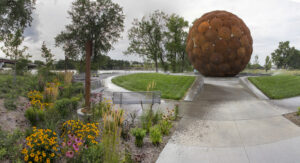
What are native plants?
Illinois offers a plethora of native plants to integrate into your home landscaping that are not only aesthetically pleasing, but they are designed to thrive in our environment. Additionally, with the growing concern over our environment and climate change, it is more important than ever to consider adding native plants to your outdoor space.
Native plants are plants that began growing in a region without being introduced by nonnative settlers. Native plants are predisposed and naturally adapted to specific climates and conditions. (AKA they are easy to grow!)
Not only do native plants grow and thrive easily, but they also are essential to our local ecosystem including birds, wildlife, beneficial insects, and imperative microorganisms that live in our native soil. These native and natural ecosystem communities of wildlife have evolved together over many years. Each piece to the puzzle relies on one another for a habitat to live, and nutrients to survive.
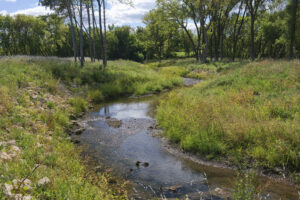
This delicate ecosystem balance can be severely compromised if invasive, and often nonnative plant species, are introduced to the ecosystem. Nonnative plants often grow quickly and choke out native plants in our area. (It is key to note that tax-payer dollars are often what pays for the control of nonnative, invasive species!) This leads to less biodiversity and disrupts the ecosystem which evolved together and relies on each other.
Think of this like baking a cake. Each ingredient in the cake is essential to making it fluffy, sweet, and delicious. Each part of the ecosystem is like an ingredient in the cake. Mess with one part (native plants) and the entire thing will fall apart.
Gilbertsen explained the importance of native plants in relation to stormwater in Illinois. “We use native plants almost exclusively [at jobsites] to help reduce flooding and recharge the groundwater,” he said.
He continued to explain that native plants offer a deeper root system here in Illinois, up to about 10 feet deep! This allows for the plants to soak in excess ground water more easily than nonnative plants (which have significantly shorter root systems). These deeper root systems also ensure the native Illinois plants are drought resistant and resilient in the extreme weather the Midwest offers.
Benefits of going native
Easy growing
As we touched on earlier, a major benefit to native plants is the ease in which they grow. Plants native to the Midwest have adapted to the harsh winter climates, summertime droughts, and they flourish in the natural soil we have.
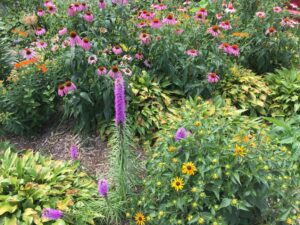
Gilbertsen stated that aside from helping with stormwater and flooding, native plants at his jobsites offer resilience. “Once they’re established, about six weeks after planting, you can essentially stop watering them and they require little to no fertilizer,” he said. Gilbertsen continued to explain that the only maintenance required for native plants is to cut them down once a year so the new plant can grow back.
Increase property value
The ease of growing should be a point of interest for homeowners. Selecting native plants not only makes maintaining your yard easier, but it also enhances our ecosystem, and can be used as a selling point for your property! Native plants are perennials. This low maintenance feature is something buyers see as a positive.
According to HomeLight, over 75% of top real estate agents in the United States said a well-landscaped home is worth from 1-to-10 percent more than homes with no landscaping.
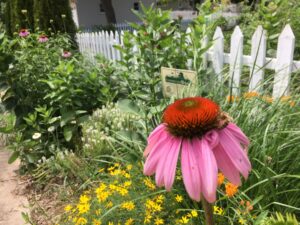
The American Society of Landscape Architects (ASLA) recommends investing 10% of your home value into landscaping, while other studies suggest you can increase your home value from 5-to-15 percent by spending the equivalent percentage on maintenance and upgrades to landscaping. Plus, the fact that native plants are virtually maintenance free makes them an even more cost-effective way to increase your property value.
A survey conducted by the National Association of Realtors (NAR) found that 17% of agents surveyed said recent landscaping done by clients lead to the sale of their property.
Gilbertsen mentioned landscaping with native plants is considered a sustainable practice, similar to solar panels or high efficiency appliances. Planting native plants is like high efficiency landscaping. He said he believes that native plants do not date the look of your home, and they also are sign that you are educated and part of modern landscaping.
Supporting pollinators
Another imperative role that native plants play is supporting our pollinators. Gilbertsen explained that bees are pollinators and we as humans rely on them for food. “Everything we eat is pollinated by bees,” he stated.
Simply put, pollinators are animals that transfer pollen to fertilize plants. Not all plants require pollinators, however about 85% of them do.
Pollinators help ensure we have food to eat. It is estimated that one in every three bites of food you take is related to the actions of pollinators. Pollinators provide more than $10 billion in economic value annually in the United States alone.
Bottom line, without pollinators many plants would not be able to reproduce; and without those plants and the food, shelter, oxygen and benefits to the ecosystem they provide, many animals including humans could not exist.
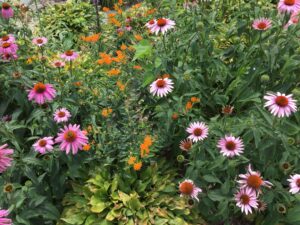
Having native plants in your landscaping provides food for the bees (and other pollinators), which in turn helps our food supply. These same native plants that attract the bees also attract butterflies and hummingbirds (other essential pollinators) for an added beautiful aesthetic to your yard. Pollinators play an extremely important role in the health, fertility, and productivity of wild plants and food plants.
In recent years, declining ecosystems have also created a decline in bee and monarch populations. Pollinators are not only on the decline in Illinois, but worldwide. As this number of pollinators declines, so does the number of viable seeds in the plants they pollinate. This leads to fewer plants, fewer flowers, and less pollen and nectar to attract the pollinators.
Integrating native plants into your landscape
Now that you understand the essential role that native plants can play in your landscaping, it is time to get planting!
Gilbertsen suggested the best place to learn about and purchase native plants is at county conservation districts. “McHenry County Land Conservancy has an annual plant sale which gives the public a chance to buy native plants at a fairly good price,” he explained. “But also, most nurseries carry a good number of native plants that are separated into their own section,” Gilbertsen said.
Selecting plants that attract pollinators is essential to making a thriving ecosystem within your landscape. Click here to learn more about making a bee-friendly outdoor space at your home!
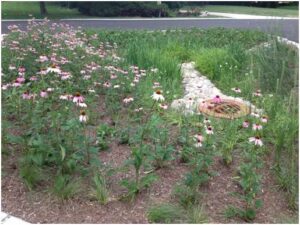
Gilbertsen also gave a piece of advice to start with a slightly established native plant, as starting from seed can be challenging, especially for beginners. Another tip, if there is an area in your yard where grass will not grow, that is likely the perfect spot to plant some water-loving natives.
He also listed some of his favorite native plants to Illinois which include a beautiful grass called Prairie Drop Seed, Prairie Blazing Star flowers, Butterfly Weed flowers, and Purple Cone flowers.
Other tips include:
- Plant native pollinator plants. Include flowering plants from early spring through late fall for beautiful design all year long, but also to provide essential food for the pollinators during all seasons. Click here to learn about bloom periods in Illinois.
- Set your mower to a higher level to provide habitat for bees.
- Purchase organic and locally grown produce.
- Limit your use of pesticides and nonnative plants.
- Save logs or tree branches to offer bees a nesting place.
- Install a native bee nesting box.
- Educate others about habitat issues.

Seeing change
Gilbertsen recounts receiving a plaque for his native plant garden through Conservation @ Home which is through the Conservation Foundation. The plaque stands for a way to show your conservation practices (think a rain barrel, native plants, trees, bird feeders etc.) and to spur your neighbors’ interest in the cause.
When asked about the most rewarding part of having a native plant garden, Gilbertsen said, “When I see animals I haven’t seen in my neighbors yard come to my yard. I have hummingbirds, bees buzzing, and more birds than any other home around me, which shows me what I’m doing is actually working.” He finished by saying he also enjoys sharing his passion for gardening and native plant ecosystems with his 4-year-old daughter. “She can actually name a bunch of the flowers and plants we have. Educating kids about [the importance of native plant gardens] is fun for me,” he concluded.





